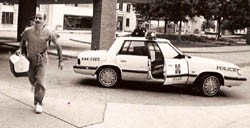 |
| 1 |  | 
A. Car Theft More than 1.2 million vehicles are stolen annually. Their value is estimated at $7.5 billion. The recovery rate for stolen vehicles is around 60 percent nationally, much lower in metropolitan areas. The national motor vehicle theft rate is 421 per 100,000 people. An average of 1 of every 125 registered vehicles is stolen each year.
California has the highest state rate of motor vehicle thefts. Detroit, has the highest city rate.
Talk to police officers, garage mechanics and others about the local car theft rate and car insurance rates. Find out the best way to protect cars against theft: alarms, steering wheel immobilizers, the Lojack, ignition cutoff systems. |
|  | |
|
|
 |
| 2 |  | 
B. Efficiency One measure of police efficiency is the comparison of arrests to citizen complaints. Take the numbers of each in the categories of burglary and robbery. In large urban areas, the ratio is about one arrest for every five reported burglaries and robberies.
You might extend this to all categories of crime, and if the community has precincts, you can make a precinct-by-precinct analysis. |
|  | |
|
|
 |
| 3 |  | 
C. Crimes Take any 1- or 2-hour period or more over the past 24 hours, and do a total of crimes reported by category. For this story, you will have to obtain the dispatcher's record or the records of the police officer who takes all incoming calls on crimes. Some of these calls may not be serious, but record them anyway. This will be a narrow peek at a period in a day of the life of a police department. |
|  | |
|
|
 |
| 4 |  | 
D. Police Interview a police officer who walks a beat or is assigned to a patrol car. Try to accompany the officer on his or her rounds or ask for a description of a typical day. Include the strong opinions the officer may have of the people he or she deals with, and ask what the officer thinks of the court system. |
|  | |
|
|
 |
| 5 |  | 
E. Service  <a onClick="window.open('/olcweb/cgi/pluginpop.cgi?it=jpg::::/sites/dl/free/0073511935/234798/W2O_1.jpg','popWin', 'width=NaN,height=NaN,resizable,scrollbars');" href="#"><img valign="absmiddle" height="16" width="16" border="0" src="/olcweb/styles/shared/linkicons/image.gif"> (17.0K)</a> <a onClick="window.open('/olcweb/cgi/pluginpop.cgi?it=jpg::::/sites/dl/free/0073511935/234798/W2O_1.jpg','popWin', 'width=NaN,height=NaN,resizable,scrollbars');" href="#"><img valign="absmiddle" height="16" width="16" border="0" src="/olcweb/styles/shared/linkicons/image.gif"> (17.0K)</a>
Susan Kirkman, Akron Beacon Journal
Rushing a heart for an organ transplant | What services does your local police department provide in addition to law enforcement? |
|
|  | |
|
|
 |
| 6 |  | 
F. Prevention Unique methods have been adopted in some cities to prevent crime. One of the most common is the computerized study of high-crime areas and periods and the assignment of officers to these areas in town during the specified times. What methods are being used in your city? |
|  | |
|
|
 |
| 7 |  | 
G. Complaints Is there a bureau or department in the city that handles complaints against the police? Do a story on the kinds of complaints registered and the way they are handled. Have any officers been suspended or fired as a result? |
|  | |
|
|
 |
| 8 |  | 
H. Con Artists Interview local law enforcement authorities to find out what kinds of illegal activities have been used to fleece residents. One of the more lucrative schemes is fraudulent telemarketing, which is aimed mostly at the elderly. Law agencies estimate that telemarketing scams cost gullible people about $40 billion a year over the last few years. There have been more than 800 arrests in the past year of these con artists who promise to deliver goods and don't or get people to enter sweepstakes in which no one actually wins.
Another scam involves credit card fraud. Con artists manage to obtain the social security numbers of an individual and apply for a card under his or her name. Local credit agencies will have information on this activity. |
|  | |
|
|

